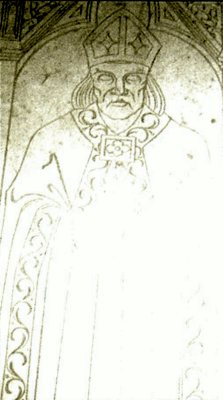Tombstone
The photograph shows the tombstone of Bishop Devie in the Cathedral of Belley.
Bishop Alexandre-Raymond Devie played an important part in the founding events of the Society of Mary. He was a man of great vision and keen to promote the Society, but his plans were different from Colin’s. Colin’s view of the Society was of an international body of people “going from place to place” for the Gospel. Bishop Devie, understandably reluctant to lose good men from his diocese, wanted the Society to remain a congregation within his diocese.
Colin respected and admired Devie. On one occasion he said, “Monsignor Devie is one of the finest examples of a bishop that I know….When he was appointed, this region was abandoned. He has totally renewed it.” But given the differences of viewpoint, it is understandable that relationships between the two men were sometimes strained. Colin said, “What made me suffer most was the opposition of the Bishop of Belley, because he was my Bishop. I wished I could have the same opinions, and when I realised that I could not think like him without dropping everything, that tore me apart.” Devie’s last words to Colin were: “If God is merciful to me, I will certainly not forget the Society of Mary in heaven.”
Foundation stones
Denis Maitrepierre was one of the 20 priests who took their vows on September 24, 1836. This is his account of the event:
“At last the 24th of September arrived; the day we had been waiting for for so long; and a day we would never forget. It was a Saturday; it was the feast of Our Lady of Mercy for the Ransom of Captives. At 5.30 in the morning we made our way from the Seminary to the House of the Marists. We said morning prayers… heard Mass said by Bishop Pompallier…said several prayers out loudtogether, then stayed for a short time in recollectionin front of the Blessed Sacrament. Then we went upstairs into one of the big rooms of the house. Here we spent more than a quarter of an hour in strict silence, recollecting ourselves, praying to Our Lord, asking him to indicate to us who it was he wanted to be in charge of the Society which was about to be born…. The voting was unanimous – everyone’s vote was for Father Colin…. Father Champagnat came up to him and began an address, speaking very distinctly and with a kind of harsh emphasis. ‘Reverend Superior, this is certainly a nasty present we have just given you; there is such a lot of unhappiness ahead of you while you are in charge. You have been lifted up to a position of importance, but only to have to face winds and storms… and on the last day you will have to answer for each of us.’ Speaking for himself and for his confreres, he made a promise to do everything possible to lighten the burden.
The thought of the work under way, this alone filled the minds of those present with solemn thoughts: they were going to lay the foundation stone, set the cornerstone of a building which was destined to rise to a great height. The world unfolded before their gaze…. The Society of Mary was in being: it no longer belonged just to the diocese of Lyon, or just to the diocese of Belley; it was catholic. The members began to leave, after a brotherly embrace and with the Superior’s blessing; off they went, filled with the ardent and sincere desire to work for the glory of God, for the honour of Mary and for the sanctification of souls.”
Cornerstone

COLIN: What imperceptibly put me at the head of the Society is that some of my confreres wanted to fight the bishops. Then I separated from them. The greatest grace I have received is that I have always kept united to the bishops. I was persuaded that nothing would succeed except through the bishops.
There was one who suggested that we go ahead despite the authorities. My brother and I had the same thought: Let the Society perish rather than go against authority. If the Society is God’s work, God will maintain it.
MAYET: If every body had left you,what would you have done?
COLIN: I would have said a “Te Deum” and I would have started over again by myself. Even if it had perished then, even it were to fail today, I would still say it has been very useful to me. It has detached me from everything….
The Mayet Memoirs

Colin’s main objective in going to Rome in 1833 was simply to present the plan of the Marist project “in order to know what Rome would think”.
The authorities in Rome made it pretty clear what they thought.
But despite that, the whole project continued to grow and to attract more people! The “Marists” were still in two dioceses, Lyons and Belley, with Champagnat looking after his Brothers and acting as the centre point for the priests of the Lyons diocese, and Colin overseeing the total project and taking care especially of the Belley group.
Colin had agreed to act as a rallying point, but there was no real superior, and Jeanne-Marie Chavoin and Marcellin Champagnat were truly equal partners. But on January 31, 1834, Rome had said a firm NO to the plan of the Society of Mary with many branches and that would seem to have put an end to it all.
However events changed in a way that the Bishop of Belle) described as an indication of the “finger of God.”
A great revival in missions to foreign lands took place in the 19th century, and the impetus goes back to the pontificate of Pope Gregory XVI, the greatest missionary Pope of that century. The vast area of Western Oceania needed evangelizing, and the work of evangelizing needed missionaries. A former missionary in Reunion was asked to take the mission. Ill health prevented him, but he suggested a group of men he had heard of as willing “to go to any part of the world for the Gospel-the group of Marists in France.
Officials met in Rome to discuss the question of Oceania. Their report contained two questions: “Is it necessary to create a new Vicariate of Western Polynesia?” Answer. Yes.
“To whom shall this mission be entrusted? Answer: “To the priests of the Marian Congregation of Lyons and Belley.”
Rome was prepared to approve one branch of the Marist project – the congregation of priests – and at this stage only one branch.
What had seemed an essential feature of the project was not allowable Jeanne-Marie Chavoin was disappointed; from the very beginning she had foreseen that her congregation would be a branch of the Society. And till his death in 1840, Marcellin Champagnat had struggled to keep a unity in the whole growing enterprise.
But perhaps for that moment in history Rome was right: a project as vast as the one laid out by Colin would be impossible to govern.
For the moment, one branch was approved by Gregory XVI on April 29, 1836. The group of aspiring Marist priests had now to select a leader, and begin their service as missionaries in the Church.